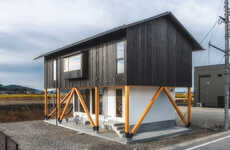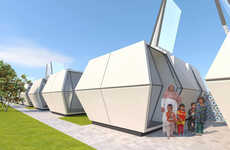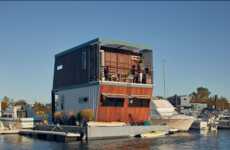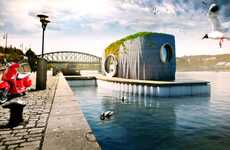
The Conceptual 'Puffer Village' Adapts to the Changing Environment
Michael Hemsworth — January 9, 2022 — Art & Design
References: yankodesign
The conceptual 'Puffer Village' has been designed by Sajjad Navidi as a smart housing system that would accommodate the changing landscape of our world in relation to climate change.
The homes would sit like spherical pods on the landscape where they would providing comfortable living on the interior on a regular basis. The upper and lower sections would inflate like a puffer fish in the face of flooding brought on by harsh storms or rising sea levels to keep inhabitants and their belongings safe.
The conceptual 'Puffer Village' is imagined for use in developing nations that are expected to bear the brunt of the effects of climate change in the near future. The planned location for the village would be in Ganvie, which is one of the largest lake villages located in Africa in the Benin region.
The homes would sit like spherical pods on the landscape where they would providing comfortable living on the interior on a regular basis. The upper and lower sections would inflate like a puffer fish in the face of flooding brought on by harsh storms or rising sea levels to keep inhabitants and their belongings safe.
The conceptual 'Puffer Village' is imagined for use in developing nations that are expected to bear the brunt of the effects of climate change in the near future. The planned location for the village would be in Ganvie, which is one of the largest lake villages located in Africa in the Benin region.
Trend Themes
1. Rising-sea-level-adaptive-housing - The demand for innovative architecture that adapts to the effects of climate change has created an opportunity for developing new housing systems.
2. Smart-housing-technology - The use of inflatable housing technology creates opportunities for developing new smart housing systems that can adapt to environmental changes.
3. Sustainable-housing-innovation - The conceptual 'Puffer Village' represents an opportunity for innovative sustainable housing systems that can accommodate the changing landscape of our world in relation to climate change.
Industry Implications
1. Architecture-and-design - Architecture and design firms can capitalize on the demand for new rising sea level adaptive housing solutions by creating and implementing innovative architecture solutions.
2. Housing-technology - The use of inflatable housing technology opens up opportunities for the development and implementation of smart housing accommodations that can adapt to environmental changes.
3. Environmental-sustainability - Opportunities for innovation in sustainable housing systems are apparent due to the effects of climate change and the need for new housing solutions in affected areas.
6.9
Score
Popularity
Activity
Freshness























